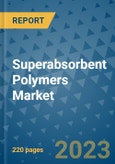Superabsorbent polymers (SAP) are revolutionizing the way we manage water absorption challenges globally. These cross-linked hydrophilic polymers have a high affinity towards liquid absorption and can retain an exceptionally large amount of aqueous fluid compared to their own mass, making them ideal for a wide range of applications.
Versatile and Efficient Water Absorption
Superabsorbent polymers are engineered to utilize osmotic pressure for liquid absorption, allowing them to retain up to 300-500 times their weight in aqueous fluid. Once absorbed, the SAP does not release the fluid, making it ideal for products designed to contain fluids, such as disposable hygiene products. SAP plays a crucial role in stabilizing the fluff and superabsorbent polymer matrix in disposable hygiene adhesives.
Key Raw Materials and Synthesis
Acrylic acid (Na or K salts), sodium hydroxide, and acrylamide are the key raw materials used in the manufacturing of superabsorbent polymers. These polymers are synthesized through gel polymerization, inverse-suspension polymerization, and solution polymerization processes. The polymerization of acrylic acid is blended with sodium hydroxide, UV initiator, and cross-linking agents to form sodium polyacrylate, which is the most popular and widely manufactured superabsorbent polymer.
Sodium Polyacrylate Dominates the Market
Sodium polyacrylate accounts for more than 80% of the total SAP production worldwide in 2019. Its versatile usage includes a wide range of hygiene and non-hygiene applications. In the agriculture sector, potassium polyacrylate is preferred for its ability to gel the absorbed water after rain or irrigation, unlike sodium polyacrylate which does not release water and hardens the soil.
Hygiene Sector Drives Demand
Disposable and personal care hygiene products are the largest consumers of superabsorbent polymers, representing almost 90% of the total SAP consumption worldwide. Diapers alone accounted for more than 3/4th of the total demand in 2019. Superabsorbent polymers have replaced traditional materials in diapers, offering efficient moisture absorption and skin protection.
Global Market and Regional Outlook
North America is currently the largest consumer of superabsorbent polymers, accounting for nearly 1/3rd of the total consumption. The region's mature disposable diaper market is expected to exhibit sluggish growth, but demand for adult incontinence products is anticipated to rise with the ageing population.
Asia Pacific is projected to be the fastest-growing market, driven by rising disposable incomes, increasing hygiene awareness, and high birth rates in countries like India, China, and Southeast Asia. The region is witnessing a significant increase in demand for baby diapers, except in Japan where the focus is on adult incontinence products.
Innovation and Capacity Expansion
Key players in the market, including Nippon Shokubai, Evonik Industries, BASF SE, SAP Global, and Sumitomo Seika Chemicals, are focusing on capacity expansion and product innovation to address hygiene product issues like odor, leakage, and rashes. LG and Archer Daniels Midland Company (ADM) signed a joint development agreement (JDA) to create 100% biobased acrylic acid production and sustainable technology for SAP.
Table of Contents
Companies Mentioned
- Nippon Shokubai Co. Ltd.
- Evonik Industries AG
- BASF SE
- SDP Global Co. Ltd.
- Sumitomo Seika Chemicals
- LG Chem
- Satellite Science & Technology Co. Ltd
- Formosa Plastics Corporation
- Yixing Danson Technology
- Quanzhou Banglida Technology Industry Co., Ltd.
- SONGWON
- Kao Corporation
Methodology

LOADING...








